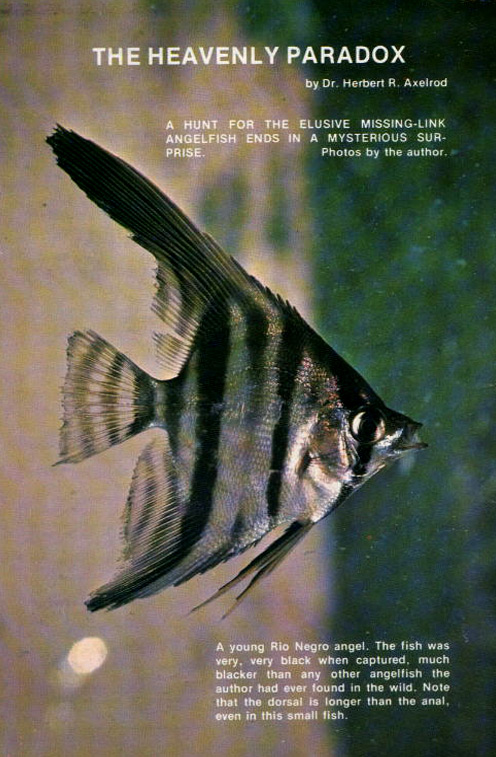
A young Rio Negro angel. The fish was very black when captured, much blacker
than any other angelfish the author had ever found in the wild. Note the dorsal
is longer than the anal, even in this small fish. This is the fish that prompted
Dr. Herbert R. Axelrod to look further into the angelfish situation to determine
whether it was a link between Pterophyllum scalare and P. altum.
|
| A young Rio Negro angel. The fish was very black when captured,... |
The greatest of all dreams are those that can never be
fulfilled. Some men dream about flying like a bird...or
diving into the sea 1,000 meters in a free-dive (and coming
back to tell about it)... my dream has been to photograph
every fish in the world. Since a dream can be fulfilled a
little at a time, I decided to photograph my fishes genus by
genus, and I started with the two genera closest to my
heart (and having the fewest species)...Symphysodon, the
discusfishes, and Pterophyllum, the angelfishes. I had
already photographed and collected every know species of
discus, and now I was about to set out to collect the
missing link in the angelfishes.
Click on map to view full size map.(90.9kb)

Fig. 1. map of the Amazon basin showing selected areas of the angelfishes' range (1-11).
|
| Fig. 1. map of the Amazon basin showing selected areas of the angelfishes' range (1-11). |
When Dr. Leonard P. Schultz worked up the genus Pterophyllum
he included in his writeup a map showing the distribution of
the various species. His map showed no collections of
angelfish in the Rio Negro of Brazil, from Manaus through
Barcelos. This area is famous for its unique fauna, since it
cantains the beautiful cardinal tetra, Cheirodon axelrodi,
and the blue discus, Symphysodon discus. The blue discus is
an example of the area's unique fauna, since it is found
only in the Rio Negro, but the cardinal tetra has been found
as far away as Columbia.
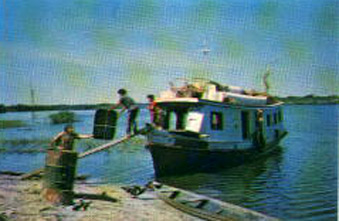
Selia Fonte handing down the collecting
nets to Dr. Axelrod.)
|
| Selia Fonte handing down the collecting
nets to Dr. Axelrod.) |
In September of 1975, I planned a trip up the Rio Negro
to collect all three fishes...The cardinal tetra, the blue
discus and the missing angelfish. As usual my trip started
in Manaus, where Willi Schwartz (Aquario Rio Negro, P.O. Box
381, Manaus, Amazonas, Brazil) has his fleet of boats used
solely for collecting aquarium fishes. Willi loaned me a
boat and a full crew. I was lucky that the crew was composed
mainly of Indians from the region of the black water (Rio
Negro). My crew chief was Selia Alfonso Fonte; he had his
wife Raimunda with us as cook, the engineer was Christian de
Braga, and the fisherman was Manoel Nena, who brought his
5-year-old son as our helper. Raul Fonte, father of Selia,
was also along, because he knew several Indian dialects.
As we left Manaus at high noon on the 7th of September, I
was amazed at the modern-looking skyline of the city. Since
it became a free port, Manaus has been growing and growing,
until now it is a modern city with traffic jams, water
shortages and brown-outs. It was delightful to get farther
out of town and lose sight of the huge white concrete
superstructures, and the air started to smell sweet...then I
saw it! Ugly black smoke pouring out of a chimney, defacing
the beautiful blue shy with a horrible scar. The jungle was
being robbed of its wood and life-giving oxygen capability
to make a very cheap quality plywood. Already filth and
debris were being dumped into the Rio Negro. How long would
it take to make the magnificent Rio Negro another Hudson or
Danube or Thames, where slime and filth kill every edible
fish? I was even happy to pass the houses of some of the
workers where the Oriental technique of waste disposal was
utilized...with the outhouse standing on posts over the
water, feeding the fish human waste. But this sophistication
degenerated into areas farther up the Rio Negro where the
whole house was elevated above the water! The advantage of
this sort of building was that it kept out most of the
crawling things, including (but not limited to) snakes,
scorpions, rats, cats, dogs, beetles, spiders and kids. It
also kept the house pretty clean...no messy basements to
worry about!
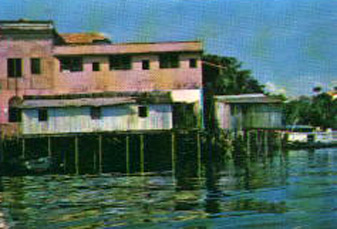
The natives' houses are built high off the water on stilts.
|
| The natives' houses are built high off the water on stilts. |
It only took us three days in our Deutz 3-cylinder
powered diesel boat, 45 feet long, to make it to Igarape
Anapichi and Igarape Apania. These are two large ditches
which swell to 1000 yards in width during the high water
season; they always contain blue discus hiding at the bases
of the submerged trees and logs. I could hardly wait for us
to find a sandy beach on which to land. I pulled out the
gangplank, walked down the skin-polished board and had Selia
hand me the nets. We picked this particular landing spot
because there were a few Indian houses there and it had a
sandy beach as contrasted to a flooded area where there is
no beach at all. In a few minutes two beautiful girls came
out to greet me. Their home was a thatched roof hut raised
about 5 feet off the ground to protect it from rising
waters.

Dr. Axelrod standing in the coffee-black flood waters.
|
| Dr. Axelrod standing in the coffee-black flood waters. |
This was exceptionally high water for September, and some
people said the water was 30 feet higher than normal. I
could believe it, for when we took two dugouts into the
"jungle" to look around we found the jungle was UNDERNEATH
us and the only thing sticking out of the water were trees
over 40 feet high! The bottom in this area was a soft carpet
of decaying leaves.
We kept going into the jungle, deeper and deeper until we
arrived at trees which grew higher. This meant, of course,
the the water was lower, since the only way we could judge
the depth of the water was by the height of the trees.
Naturally those trees growing on hills looked taller, since
they stuck out of the more. Finally we were joined by other
Indians, who took us to an area where we could stand in
knee-deep water. I gently stepped into the coffee-black
water; I looked like the "great white hunter" with my plaid
shirt and straw hat, quite in contrast to some of the
Indians. There were thousands of tiny fishes moving about,
and catching them with so much debris in the water would be
quite a problem. The bottom was soft and gentle, because it
had several feet of leaves padding each of my steps. These
leaves were brewing, like tea leaves, gently turning the
water blacker and blacker as the rain tried in vain to
dilute the tannic acid. The pH was rather high (for the Rio
Negro) at this time, almost 5.0, and the water temperature
varied from 82 degrees to 90 degrees, with an air
temperature of 84 degrees. How proud I was of the accurate
thermometer that I used! Dr. Schultz had given it to me in
1953.
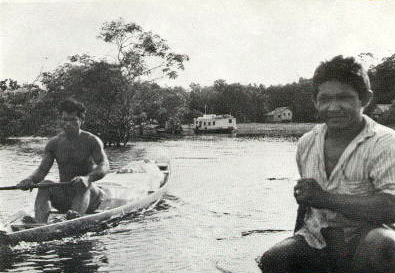
In the background is our motor launch, the Arapaima, which we obtained from
Willi Schwartz. This launch made the trip up and down the major rivers of Brazil
a hundred times! The Indian on the right is Selia Fonte. On the left is Manoel
Nena, who is carrying the nets and plastic containers in which we will store the fishes.
|
| In the background is our motor launch, the Arapaima,... |
We cleared an area of about 20 feet square and collected
some of the fishes. They were mostly tetras of a rather
unspectacular color, but a beautiful striped Leporinus, a
lovely dwarf cichlid and a score of 2-inch long piranhas
were the highlights of our efforts. Where were the discus
and angelfishes? Didn't you know these fishes hide and run
away from the slightest disturbances during the day? You
might catch the occasional angelfish with a seine, but try
catching a discus! Never!
So, back to the boat Arapaima. By the way, the name
"Arapaima" is the name of the largest Amazonian fish,
Arapaima gigas. This boat was named after the fish because
when it was named it was the largest boat the Willi
had...today it is the smallest! The fish business was good
to Willi, I guess.
On the boat we had a little siesta. I had my usual
meal...spaghetti. I ate spaghetti, by the way, everyday for
10 days. It was the only food I had. We couldn't catch fish
large enough to eat since the water was so high and our
50-foot seines were useless...so all we had was spaghetti
and sun-dried, smelly beef. I preferred the spaghetti.
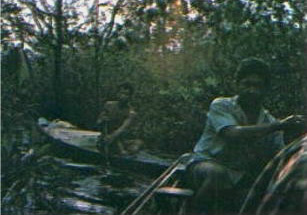
Proceeding deeper and deeper into the jungle, the trees were showed more of their trunks above the water line.
|
| Proceeding deeper and deeper into the jungle, the trees were showed more of their trunks above the water line. |
As the party proceeded deeper and deeper into the jungle
the trees showed more of their trunks above the water line;
it was assumed that the water depth in this flooded area was
less than in the other flooded areas, depth of the water was
being judged by the height of the trees extending above it.
Eventually a spot was reached in the jungle at which the
water was only knee-deep. Dugouts were maneuverable above
the flooded jungle floor until the water became too low for
navigation.
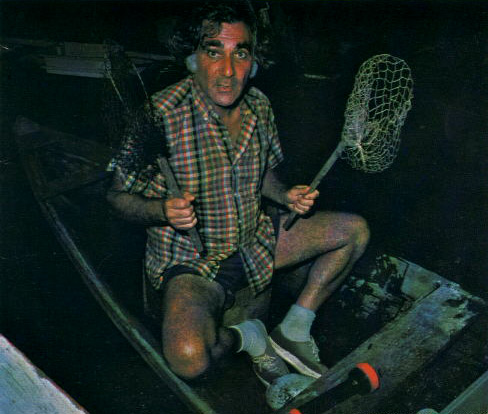
I guess I looked rather silly, anxiously awaiting the Indians to join me in a very rocky dugout canoe to catch discus and angelfish at night. We were so lucky that the mosquitoes were sleeping.
|
| I guess I looked rather silly,... |
At 7 pm it was time to get up. Night-fishing for
angelfish and discus was on the schedule, and I was so
exited I could hardly wait. I jumped into the dugout with my
waterproof flashlight, two dipnets and a plastic box and was
ready to go. I felt a little foolish as I waited almost an
hour for the rest of the crew to come with me. Selia and his
wife showed me their secret weapon. They took an ordinary
flashlight and attached it to a headpiece which was quite
comfortable. Then, using a regular automobile battery, they
had hours of power...and a strong rechargeable battery. My
dry cells lasted only an hour!
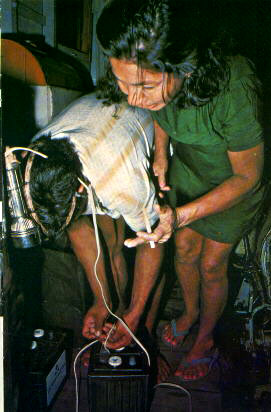
Silas ("Silia") Fonte charges his battery-operated headlamp from an automobile battery as his wife stands by ready to shove another cigarette into his mouth.
|
| Silas ("Silia") Fonte charges his battery-operated headlamp... |
The team of the husband and wife Fontes was remarkable.
They spoke very few words, but Mrs. Fonte would light a
cigarette and shove it into her husband's mouth, whether he
wanted it or not. Finally, everything was ready, and we
quietly paddled the few hundred yards from our parked boat
to the thick trees. I fished in the same boat as Selia Fonte;
two other boats joined us, fishing in other areas.
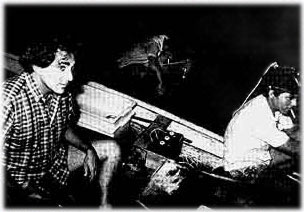
An actual fishing scene. In the background is Silas, slowly bringing his net under a fish.
|
| An actual fishing scene. In the background is Silas, slowly bringing his net under a fish. |
We were very quiet and heard every little noise.
Expertly, Selia pulled the boat through the trees, slowly
and methodically training his head-mounted flashlight into
the water. Though the water was black, the light could
penetrate about a foot deep, and the shiny, reflective
quality of the scales of a fish was so obvious that we
didn't miss very much. Our Indian engineer has a head-set
connected to a car battery and two plastic containers in his
dugout in which he can carry his fish back. Suddenly I saw a
telltale shine. It took me a few seconds to recognize that
it was an angelfish and I carefully netted the fish, slowly
bringing the net up under it. The fish was about 6 inches
under the surface of the water, and resting almost against a
tree, protected from almost all sides and from below. We
caught about 8 angelfish that night, and here are the notes
from my diary:
"The two specimens of Pterophyllum which were under 5 cm.
were long-finned and dark. Certainly this is the stock from
which the longfinned and black angels derived. They were not
hybrids after all!! Maybe that's why no one ever stepped
forward to take credit for having developed them??"
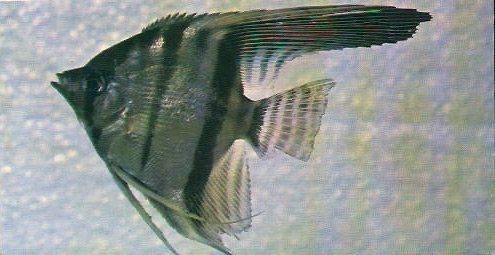
The Rio Negro angelfish that prompted Dr. Axelrod to look further into the angelfish situation to determine whether it was a link between Pterophyllum scalare and P. altum.
|
| The Rio Negro angelfish that prompted Dr. Axelrod to look further into the angelfish situation... |
By the time I was able to photograph them, they had faded
substantially, but they still showed a lot of black on their
bodies and in their fins. As I studied the angelfish I
became more and more excited!! Their dorsal fins were twice
as long as their anal fins. This gave them a very weird
appearance... like the marine Moorish idol! Possibly this
was a new species. The more I studied them, the more I was
sure they were something important. I could hardly wait to
get back to compare them with Pterophyllum altum, which I
found even after having found enough of the missing links in
the distribution of the angelfish in the Amazon River
system, I still had discus and cardinals to collect...and
write about, since no one has ever photographed their range
and habitat. I'll let Warren Burgess finish the story about
my new angelfishes! |